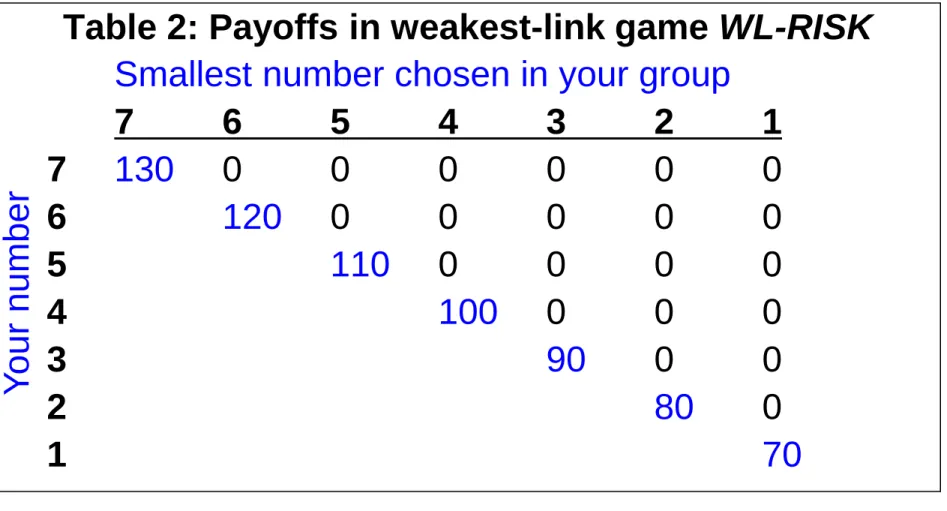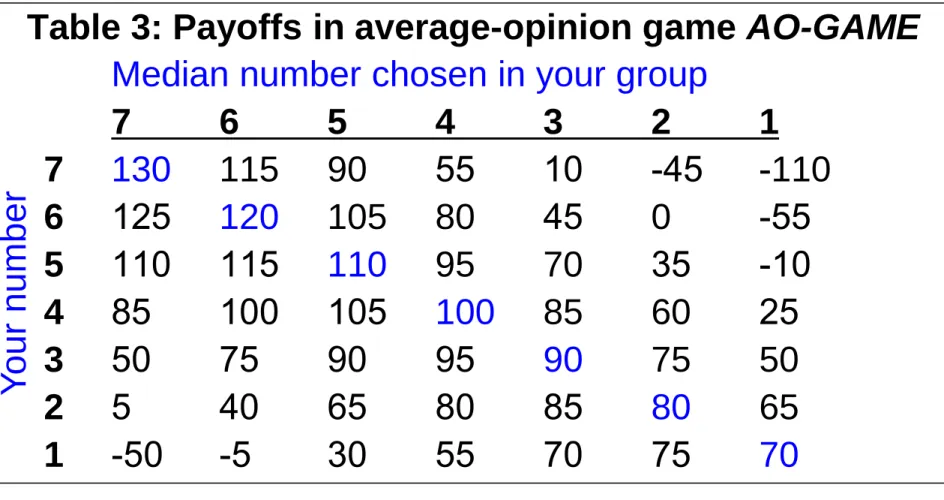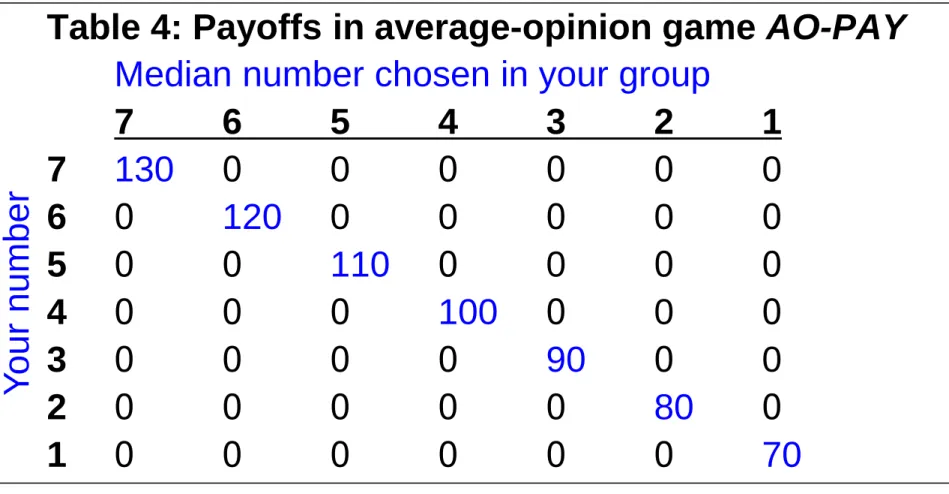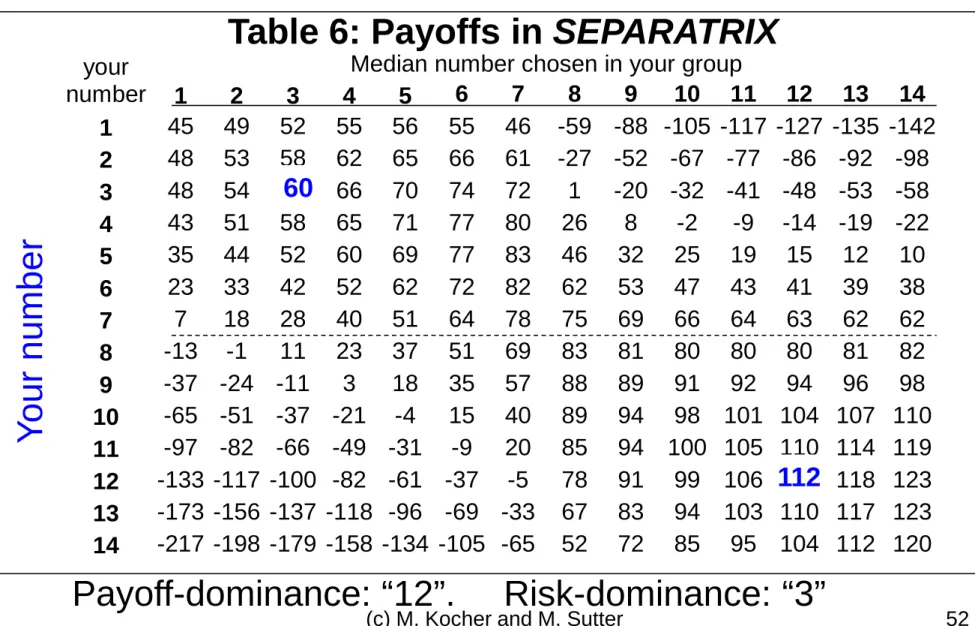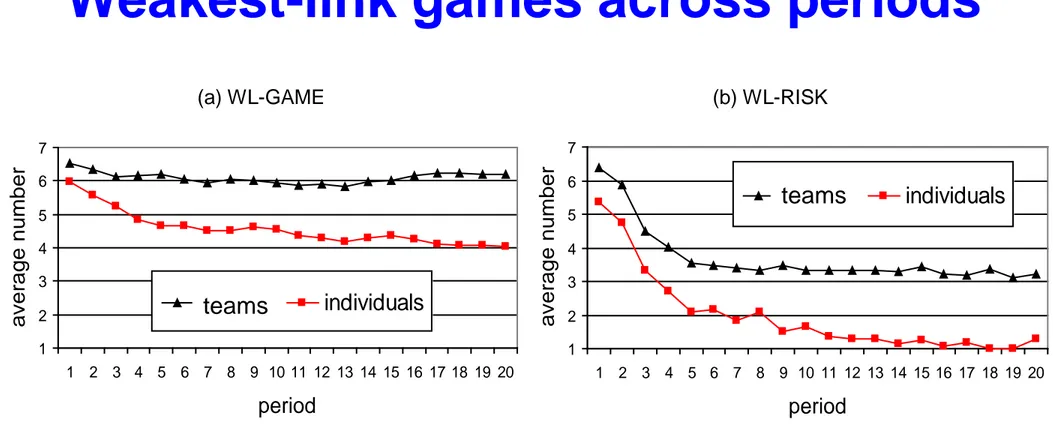Team decision-making
Martin Kocher
University of Munich
Course in Behavioral and Experimental
Economics
(c) M. Kocher and M. Sutter 2
Motivation
The ‘decision maker’ is usually modeled as an individual in economics, but many real-life decisions are team
decisions.
Think of (hiring) committees, executive boards, advisory boards, households, etc. deciding on job offers,
monetary policy, corporate business strategy, judicial questions, household savings ...
(c) M. Kocher and M. Sutter 3
Motivation
• (Social) Psychology has long been interested in
comparing team decisions to individual decisions, but has provided rather mixed results (see Levine and
Moreland, 1998, in Handbook of Social Psychology).
• Team decision making has captured vivid interest in (behavioral) economics only in recent years (see the top ten open research questions of Camerer, 2003).
(c) M. Kocher and M. Sutter 4
Some open questions
• Do teams make different decisions than individuals – and under which circumstances?
• Which decision maker is more ‘successful‘ in strategic interaction?
• What drives team decision-making?
(c) M. Kocher and M. Sutter 5
Preview
- Bargaining and social preferences
+ Ultimatum game (Bornstein and Yaniv, 1998) + Centipede game (Bornstein et al., 2004)
- Price competition (Bornstein and Gneezy, 2002) - Signaling game (Cooper and Kagel, 2005)
- Guessing game (Kocher and Sutter, 2005)
- Coordination games (Feri, Irlenbusch and Sutter, 2010)
(c) M. Kocher and M. Sutter 6
Bargaining
• Bargaining often takes place between teams (think of negotiations on company mergers, peace treaties,
…).
• The seminal paper that studies differences between individuals and teams in simple bargaining games is by Bornstein and Yaniv (1998).
• They use the ultimatum game by Güth et al. (1982).
(c) M. Kocher and M. Sutter 7
The ultimatum game
• 2 players (proposer and responder) bargain how to split an amount X.
• 2 stages:
• Proposer offers s to responder, keeping X – s.
• Responder has 2 options
– Responder accepts the offer s:
payoffs Proposer: X-s
Responder: s
– Responder rejects the offer s:
payoffs Both receive zero (0)
(c) M. Kocher and M. Sutter 8
They conduct two treatments of the ultimatum game – Individuals: Both proposer and responder are
individuals.
– Teams: Teams of three subjects each are either in the role of proposer or responder.
Per-capita incentives constant.
Team decision made after 10 minutes of discussion.
One-shot game.
Control-treatment with double-blind procedure.
Bornstein and Yaniv (1998) – Design
(c) M. Kocher and M. Sutter 9
Three main hypotheses
1. Teams are more competitive (discontinuity-effect of Insko and Schopler, 1992).
Lower offers and higher rejection rates of teams.
2. Teams make less mistakes and are, thus, more rational.
Lower offers, but no difference in rejection rates.
3. Teams are more normative (a bit vague in the paper).
Identical offers, but lower rejection rates.
Bornstein and Yaniv (1998) - Hypotheses
(c) M. Kocher and M. Sutter 10
Bornstein and Yaniv (1998) – Results
Single-blind
Double-blind
• Teams offer significantly less. There are almost no rejections. Teams are “more rational”.
• There is no significant difference between single- and double-blind.
(c) M. Kocher and M. Sutter 11
Additional evidence on bargaining
• Cason and Mui (1997): Dictator game – Teams give more.
• Luhan et al. (forthcoming): Dictator game – Teams give less.
• Kocher and Sutter (2007): Gift exchange game – Teams choose higher wages, but less effort.
• Cox (2002) and Kugler et al. (2007): Trust game – Teams give less and give back less.
(c) M. Kocher and M. Sutter 12
They test team vs. individual behavior in two versions of the centipede game, where two players alternate in moves.
The increasing-sum centipede game
Another test on “rationality” – Bornstein,
Kugler and Ziegelmeyer (2004)
(c) M. Kocher and M. Sutter 13
The constant-sum centipede game
Bornstein et al. (2004)
(c) M. Kocher and M. Sutter 14
Two treatments
– Individuals: Both players are individuals.
– Teams: Both players are teams of three subjects.
Constant per-capita incentives, and free-form communication.
One-shot game.
Standard equilibrium is to “Take” at first node.
Bornstein et al. (2004) – Design
(c) M. Kocher and M. Sutter 15
Bornstein et al. (2004) – Results
∅ node 5.22
∅ node 4.44
2.56 2.00
p < 0.01
p < 0.05
(c) M. Kocher and M. Sutter 16
Social psychology offers some explanations for the earlier exit of the game by teams (called “groups” in Bornstein et al., 2004).
Among them are
- Stronger concerns for own payoffs in teams - Less identifiability in teams
- More competitiveness of teams because they expect other teams to be more competitive.
Bornstein et al. (2004) – Results
(c) M. Kocher and M. Sutter 17
The previous papers – and the final ones – compared
individual and team decision-making where the payoffs in teams were identical across members.
Yet, it seems natural to ask what happens to team decisions if a team’s decision may yield different payoffs for its
members, hence when conflict is possible.
Think of two conglomerates of firms competing against each other (in building a new airplane, for instance). Then there might be internal conflicts within a conglomerate.
Team decision-making from a different
angle – Bornstein and Gneezy (2002)
(c) M. Kocher and M. Sutter 18
• They study duopolistic price competition.
• Teams consist of 3 members (10 cohorts of 12 subjects).
• Team composition changes in each of 100 rounds.
• Two teams compete in prices.
• Each team member submits an integer bid from {2, …, 25}.
• The team with the smaller sum of bids wins the game and earns its sum of bids. The losing team earns nothing.
• Two treatments
+ Non-cooperative. Each member receives his bid.
+ Cooperative. Equal division of sum of bids.
Bornstein and Gneezy (2002) – Design
(c) M. Kocher and M. Sutter 19
Cooperative team decisions lead to lower bids less free- riding on other team members. Internal conflicts in non-
cooperative condition have impact on competition.
Bornstein and Gneezy (2002) – Results
Mean bid per round
(c) M. Kocher and M. Sutter 20
Consider a situation where a monopolist faces a possible entrant. The entrant does not know the monopolist’s cost type (either high or low), but can only observe the
monopolist’s choice of quantities. What shall the monopolist do? Which signal should he send, and how should the
possible entrant react?
Such a situation has been modeled as an “entry limit pricing game” by Milgrom and Roberts (1982).
Cooper and Kagel (2005) have observed individual and team play in such a game.
Signaling games – Strategic play
(c) M. Kocher and M. Sutter 21
Strategic play in such a game takes place through limit pricing, which means to choose larger quantities than would prevail in the absence of asymmetric information.
Cooper and Kagel were interested in testing how the “type of decision-maker” affects strategic play in such games.
Signaling games – Strategic play
(c) M. Kocher and M. Sutter 22
• Monopolist (M)
– Type: high cost (MH) or low cost (ML) with equal probability
– Chooses output level
• Possible entrant (E) – Knows probability of
ML or MH
– Receives signal
through chosen output level
– Enters the market or not (IN or OUT)
Basic game
(c) M. Kocher and M. Sutter 23
Monopolist‘s payoffs
• Monopolists prefer OUT over IN.
• MLs prefer generally higher outputs than MHs. (Myopic best choice would be 4 for ML, and 2 for MH.)
• “6” and “7” are dominated choices for MH. Thus, choosing “6”
may distinguish an ML from an MH.
(c) M. Kocher and M. Sutter 24
Entrant‘s payoffs
Entrants have either high costs (top) or low costs (bottom). Costs are exogenously determined.
(c) M. Kocher and M. Sutter 25
For high-cost entrants (the expected value of OUT is larger than the expected value of IN) there are both pooling and separating equilibria.
• In the pooling equilibria both types of monopolists choose any quantity from “1” to “5”, and the entrant stays OUT.
• In the separating equilibria the MLs choose “6”, and MHs choose “2”, since they cannot benefit from imitating an ML.
The entrant enters against MH, but stays out against ML.
For low-cost entrants (IN has higher expected value as OUT) only the separating equilibria from above remain.
Predictions for the game
(c) M. Kocher and M. Sutter 26
They run three conditions - Only high-cost entrants.
- Only low-cost entrants.
- First high-cost entrants and then low-cost entrants (crossover-treatments to examine transfer learning).
All conditions are run both with - Individuals.
- Teams of two subjects who can communicate via chat. In case of no agreement on quantity within 3 minutes, one member is determined as “leader” who can decide.
Cooper and Kagel (2005) – Design
(c) M. Kocher and M. Sutter 27
Hypothesis 1: There will be more strategic play of teams than of individuals.
Strategic play is defined as MHs choosing “3” to “5”, and
MLs choosing “5” to “7”. These levels are above the myopic best choice of “2” for MHs, and “4” of MLs.
Hypothesis 2: The level of strategic play of teams will meet or beat a truth-wins norm.
Let p (P) be the probability of an individual (team) playing strategically, then teams beat the truth wins-norm if
P ≥ 1 – (1 – p)².
Cooper and Kagel (2005) – Hypotheses
(c) M. Kocher and M. Sutter 28
- Teams in the role of MH act a bit more strategically (p < 0.1 in cycle 1), but a truth wins norm is not reached.
High-cost entrants – Results
Proportion of strategic play of MHs.
Individuals Teams
Simulated teams
(c) M. Kocher and M. Sutter 29
- Teams in the role of ML act significantly more often strategically (p < 0.05 in all cycles).
Low-cost entrants – Results
Proportion of strategic play of MLs.
Individuals Teams
Simulated teams
(c) M. Kocher and M. Sutter 30
Monopolists start facing high-cost entrants (for 2 cycles, i.e. 24 periods, in inexperienced mode, and 1 cycle, i.e. 8 periods, in experienced mode).
Then there is a switch to low-cost entrants (for another 3 cycles, i.e. 24 periods).
This crossover treatment allows examining the transfer of knowledge acquired in a specific strategic situation to a similar one.
In particular, it allows to analyse whether teams are better in learning transfer. The answer is clearly “Yes” (contrary to the authors’ Hypothesis 3).
Cooper and Kagel (2005) –
The crossover treatments
(c) M. Kocher and M. Sutter 31
- After the crossover, teams play much more strategically than individuals.
Crossover treatment – Results
Proportion of strategic play of MLs.
Individuals Teams
Simulated teams
(c) M. Kocher and M. Sutter 32
- After the crossover, teams play more strategically, but individuals less. Better learning transfer in teams.
Transfer – Results
Proportion of strategic play of MLs.
Teams after crossover (CO) Teams before CO
Individuals before CO
Individuals after CO
(c) M. Kocher and M. Sutter 33
Analyzing the team dialogues (one of the novel parts of this paper for an economics audience!) reveals that strategic play and learning in the crossover-games depend critically on teams discussing how the strategic situation is viewed from the entrant’s perspective! Putting yourself in the shoes of the entrant reveals the possibility of pooling or separating equilibria.
(One note on limitation: It would be desirable to have access also to individuals’ stream of thinking to compare it to the team dialogues. However, …)
Some insights from the team dialogues
(c) M. Kocher and M. Sutter 34
Team behavior in the guessing game
The guessing game
• N decision makers simultaneously choose a real number from the interval [0, 100].
• The winner is the decision maker whose number is closest to 2/3 of the average number.
• The game’s unique equilibrium is to choose zero.
(c) M. Kocher and M. Sutter 35
Hypotheses
(based on information load theory; Chalos and Pickard, 1985)
1. Convergence to equilibrium
– Teams apply more steps of reasoning and pick lower numbers than individuals.
2. Relative performance
– Teams win more often than individuals when competing against each other (or are teams prone to the ‘curse of sophistication’?)
3. Influence of team size
– Larger teams should be more successful and converge faster to the equilibrium.
(c) M. Kocher and M. Sutter 36
Kocher and Sutter (2005) – Design
Experiment 1
• Teams compete against teams (2 sessions; N = 35 in total)
• Individuals compete against individuals (2 sessions; N = 35 in total)
• 4 round
• Winner takes all (about 10 Euro)
• Feedback on all numbers.
• Paper and pen in large classes
(c) M. Kocher and M. Sutter 37
Kocher and Sutter (2005) – Convergence to equilibrium
Median number
0 5 10 15 20 25 30 35
1 2 3 4
Round
Teams Individuals
Teams choose significantly lower numbers, except for round 1.
(c) M. Kocher and M. Sutter 38
Relative performance in the
guessing game (Kocher, Strauß and Sutter 2006, GEB)
Part I:
N = 3 individuals play the game once no feedback Self-selection phase:
Subjects can decide whether to play alone or in a team of three subjects (about 60% want to play in a team)
Part II:
2 individuals and 1 team paired for 4 rounds regular feedback on others‘ numbers
(c) M. Kocher and M. Sutter 39
Kocher et al. (2006) – Results
0 5 10 15 20 25 30 35 40 45
Part One Round 1 Round 2 Round 3 Round 4
Individuals Team members
Individual choices part I
Teams
Individuals
Team members choose significantly higher numbers in part I (as individuals), but significantly lower numbers in part II (as teams).
(c) M. Kocher and M. Sutter 40
0 0.5 1 1.5 2 2.5 3 3.5 4 4.5
Round 1 Round 2 Round 3 Round 4
Average profits in euros
Individuals Teams
Kocher et al. (2006) – Results
Average profits in Euro
Individuals Teams
Teams earn significantly larger amounts
(c) M. Kocher and M. Sutter 41
• Subjects select into teams because of the (ex post
correct!) expectation of earning higher profits in teams.
• Subjects’ main motive for individual decision-making is a preference for deciding alone, without the need for
compromise and discussion.
• Individual decision-makers correctly guess (after the
experiment) that teams won more money, however they indicate to be as happy with their role as team members do.
• Thus, subjects are willing to pay a price for their preference to decide alone.
Kocher et al. (2006) – Self-selection
(c) M. Kocher and M. Sutter 42
• No study has ever considered more than two ‘sizes’
of decision makers.
• However, team size may affect (the quality of) decision making (see information load theory).
• 3 different decision makers interact for 4 rounds – 1 individual
– 1 team with 2 members – 1 team with 4 members
Sutter (2005, EL) – Influence of team size
(c) M. Kocher and M. Sutter 43 Average numbers
0 5 10 15 20 25 30 35 40 45
Round 1 Round 2 Round 3 Round 4
Individual 2 members 4 members
Sutter (2005) – Results
Larger teams choose smaller numbers (significant in all rounds)
(c) M. Kocher and M. Sutter 44 Absolute win frequency
0 2 4 6 8 10 12 14 16 18
Round 1 Round 2 Round 3 Round 4
number of wins
Individual 2 members 4 members
Sutter (2005) – Profits
Larger teams win more often.
(c) M. Kocher and M. Sutter 45
Surprisingly, so far there have only been (experimental) studies that investigate the coordination behavior of
individuals, whereas the behavior of teams has not been examined (see the excellent survey of Devetag and
Ortmann, 2007).
However, team decision-making and coordination across teams is a widespread phenomenon. For instance, Knez and Simester (2001) illustrate in a very nice field study the need for coordination among teams at Continental Airlines to manage on-time departures and arrivals.
Teams in coordination games
(c) M. Kocher and M. Sutter 46
Feri, Irlenbusch and Sutter (2010) – Design
- 2 weakest-link games (alias minimum-games) - 4 average-opinion games (alias median-games)
- 5 decision makers constitute a “group”: either 5 individuals or 5 teams á three subjects (chat communication)
- 20 periods with partner-matching
- Feedback: Minimum/Median in particular period - Computerized (Fischbacher, 2007)
- Average duration: 45-65 minutes
- Average payoff: 9€, plus 2.5€ show-up fee
(c) M. Kocher and M. Sutter 47
The weakest-link game WL-GAME
Table 1: Payoffs in weakest-link game WL-GAME Smallest number chosen in your group
7 6 5 4 3 2 1
7 130 110 90 70 50 30 10
6 120 100 80 60 40 20
5 110 90 70 50 30
4 100 80 60 40
3 90 70 50
2 80 60
1 70
Your number
Payoff-dominance: “7” Risk-dominance: “1”
(c) M. Kocher and M. Sutter 48
The weakest-link game WL-RISK
Table 2: Payoffs in weakest-link game WL-RISK Smallest number chosen in your group
7 6 5 4 3 2 1
7 130 0 0 0 0 0 0
6 120 0 0 0 0 0
5 110 0 0 0 0
4 100 0 0 0
3 90 0 0
2 80 0
1 70
Your number
Payoff-dominance: “7” Risk-dominance: “1”
(c) M. Kocher and M. Sutter 49
The average-opinion game AO-GAME
Table 3: Payoffs in average-opinion game AO-GAME Median number chosen in your group
7 6 5 4 3 2 1
7 130 115 90 55 10 -45 -110
6 125 120 105 80 45 0 -55
5 110 115 110 95 70 35 -10
4 85 100 105 100 85 60 25
3 50 75 90 95 90 75 50
2 5 40 65 80 85 80 65
1 -50 -5 30 55 70 75 70
Your number
Payoff-dominance: “7” Risk-dominance: “3”
(c) M. Kocher and M. Sutter 50
The average-opinion game AO-PAY
Table 4: Payoffs in average-opinion game AO-PAY Median number chosen in your group
7 6 5 4 3 2 1
7 130 0 0 0 0 0 0
6 0 120 0 0 0 0 0
5 0 0 110 0 0 0 0 4 0 0 0 100 0 0 0
3 0 0 0 0 90 0 0
2 0 0 0 0 0 80 0
1 0 0 0 0 0 0 70
Your number
Payoff-dominance: “7” Risk-dominance: n.a.
(c) M. Kocher and M. Sutter 51
The average-opinion game AO-RISK
Table 5: Payoffs in average-opinion game AO-GAME Median number chosen in your group
7 6 5 4 3 2 1
7 70 65 50 25 -10 -55 -110 6 65 70 65 50 25 -10 -55
5 50 65 70 65 50 25 -10
4 25 50 65 70 65 50 25
3 -10 25 50 65 70 65 50
2 -55 -10 25 50 65 70 65
1 -110 -55 -10 25 50 65 70
Your number
Payoff-dominance: n.a. Risk-dominance: “4”
(c) M. Kocher and M. Sutter 52
The average-opinion game SEPARATRIX
Your number
Payoff-dominance: “12”. Risk-dominance: “3”
Median number chosen in your group your
number 1 2 3 4 5 6 7 8 9 10 11 12 13 14 1 45 49 52 55 56 55 46 -59 -88 -105 -117 -127 -135 -142 2 48 53 58 62 65 66 61 -27 -52 -67 -77 -86 -92 -98 3 48 54 60 66 70 74 72 1 -20 -32 -41 -48 -53 -58 4 43 51 58 65 71 77 80 26 8 -2 -9 -14 -19 -22 5 35 44 52 60 69 77 83 46 32 25 19 15 12 10 6 23 33 42 52 62 72 82 62 53 47 43 41 39 38 7 7 18 28 40 51 64 78 75 69 66 64 63 62 62 8 -13 -1 11 23 37 51 69 83 81 80 80 80 81 82 9 -37 -24 -11 3 18 35 57 88 89 91 92 94 96 98 10 -65 -51 -37 -21 -4 15 40 89 94 98 101 104 107 110 11 -97 -82 -66 -49 -31 -9 20 85 94 100 105 110 114 119 12 -133 -117 -100 -82 -61 -37 -5 78 91 99 106 112 118 123 13 -173 -156 -137 -118 -96 -69 -33 67 83 94 103 110 117 123 14 -217 -198 -179 -158 -134 -105 -65 52 72 85 95 104 112 120
112 60
Table 6: Payoffs in SEPARATRIX
(c) M. Kocher and M. Sutter 53
Experimental procedure
Experiments run in academic year 2006/07
- Weakest-link games at University of Cologne
- Average-opinion games at University of Innsbruck Participants # groups (N) Game Ind. Teams Ind. Teams
WL-GAME 90 135 18 9
WL-RISK 30 90 6 6
AO-GAME 30 90 6 6
AO-PAY 30 90 6 6
AO-RISK 30 90 6 6
SEPARATRIX 30 90 6 6
Σ = 825
(c) M. Kocher and M. Sutter 54
Feri, Irlenbusch and Sutter (2010) – Results
Table 7: Average numbers in 1st period and overall
1st period All periods
Coordination game Individual Team Individual Team
WL-GAME (Tab. 1) 5.98 <** 6.53 6.06 <* 6.56 WL-RISK (Tab. 2) 5.37 <*** 6.37 1.97 < 3.70
AO-GAME (Tab. 3) 5.67 < 6.17 6.57 <** 6.94
AO-PAY (Tab. 4) 5.33 <*** 6.43 6.04 <** 6.95
AO-RISK (Tab. 5) 4.43 ≈ 4.40 4.07 ≈ 4.03
SEPARATRIX (Tab. 6) 7.90 <*** 11.03 9.80 <** 12.63
Observations 1: Teams choose higher numbers.
Observations 2: Teams get significantly higher payoffs.
(except in AO-RISK where payoff-dominance does not apply)
(c) M. Kocher and M. Sutter 55
Weakest-link games across periods
Figure 1: Average numbers chosen in the weakest-link games
(a) WL-GAME (b) WL-RISK
1 2 3 4 5 6 7
1 2 3 4 5 6 7 8 9 10 11 12 13 14 15 16 17 18 19 20
period
average number
groups individuals
1 2 3 4 5 6 7
1 2 3 4 5 6 7 8 9 10 11 12 13 14 15 16 17 18 19 20
period
average number
groups individuals
teams
teams
(c) M. Kocher and M. Sutter 56
Average-opinion games across periods
(a) AO-GAME (b) AO-PAY
1 2 3 4 5 6 7
1 2 3 4 5 6 7 8 9 10 11 12 13 14 15 16 17 18 19 20
period
average number
groups individuals
1 2 3 4 5 6 7 8 9 10 11 12 13 14
1 2 3 4 5 6 7 8 9 10 11 12 13 14 15 16 17 18 19 20
period
average number
groups individuals
1 2 3 4 5 6 7
1 2 3 4 5 6 7 8 9 10 11 12 13 14 15 16 17 18 19 20
period
average number
groups individuals
1 2 3 4 5 6 7
1 2 3 4 5 6 7 8 9 10 11 12 13 14 15 16 17 18 19 20
period
average number
groups individuals
(c) AO-RISK (d) SEPARATRIX
teams
teams
teams
teams
(c) M. Kocher and M. Sutter 57
Miscoordination and adjustments across periods
Observation 3: Teams are more successful in avoiding miscoordination and settle quicker in an equilibrium.
Table 8: Coordination and adjustment
Miscoordination Adjustment
Coordination game Individual Team Individual Team
WL-GAME (Tab. 1) 0.65 >** 0.30 0.60 >* 0.29 WL-RISK (Tab. 2) 0.39 >* 0.29 0.53 >** 0.21 AO-GAME (Tab. 3) 0.14 >*** 0.06 0.09 >** 0.03
AO-PAY (Tab. 4) 0.25 >** 0.03 0.34 >* 0.02
AO-RISK (Tab. 5) 0.12 > 0.04 0.10 > 0.01
SEPARATRIX (Tab. 6) 0.84 >*** 0.51 0.98 >*** 0.56
(c) M. Kocher and M. Sutter 58
What drives team behavior?
In psychology, team decision-making is often related to a so-called “truth wins”-norm (in demonstrable tasks). I.e., if one team member advocates the “true” solution, then the others are easily convinced for that.
We examine whether the observed team behavior can be explained by a
- “payoff-dominance wins”-norm, or a - “risk-dominance wins”-norm.
(c) M. Kocher and M. Sutter 59
A simulation approach
We take the observed individual data (in a given game and period) and randomly assign three individuals into a
team. If one of the individuals has chosen the payoff-
dominant (or the risk-dominant) action, then we assume that the team would have chosen that action as well.
We run 100,000 simulations (per game and period) and calculate from that the expected frequency of playing either the payoff-dominant or the risk-dominant action.
We also calculate confidence-intervals to check whether the actually observed team-decisions lie within these
intervals.
(c) M. Kocher and M. Sutter 60
Simulation results on payoff-dominance in weakest-link games
0 0.2 0.4 0.6 0.8 1
1 2 3 4 5 6 7 8 9 10 11 12 13 14 15 16 17 18 19 20 period
proportion of payoff dominant play
simulated groups individuals groups
0 0.2 0.4 0.6 0.8 1
1 2 3 4 5 6 7 8 9 10 11 12 13 14 15 16 17 18 19 20 period
proportion of payoff dominant play simulated groups individuals groups
(a) WL-Game (b) WL-RISK
Rel. freq. payoff-dominant choice
Individuals Teams Simulated teams (with confidence intervals)
(c) M. Kocher and M. Sutter 61
Simulation results on payoff-
dominance in average-opinion games
0 0.2 0.4 0.6 0.8 1
1 2 3 4 5 6 7 8 9 10 11 12 13 14 15 16 17 18 19 20 period
proportion of payoff dominant play
simulated groups individuals groups
0 0.2 0.4 0.6 0.8 1
1 2 3 4 5 6 7 8 9 10 11 12 13 14 15 16 17 18 19 20 period
proportion of payoff dominant play
simulated groups individuals groups
0 0.2 0.4 0.6 0.8 1
1 2 3 4 5 6 7 8 9 10 11 12 13 14 15 16 17 18 19 20 period
proportion of payoff dominant play
simulated groups individuals groups
(a) AO-GAME (b) AO-PAY
(c) SEPARATRIX
Observation 4: The more efficient coordination in teams can be explained by a “payoff-dominance wins”-norm.
(c) M. Kocher and M. Sutter 62
Simulation results on risk- dominance
0 0.2 0.4 0.6 0.8 1
1 2 3 4 5 6 7 8 9 10 11 12 13 14 15 16 17 18 19 20 period
proportion of risk dominant play
simulated groups individuals groups
0 0.2 0.4 0.6 0.8 1
1 2 3 4 5 6 7 8 9 10 11 12 13 14 15 16 17 18 19 20 period
proportion of risk dominant play
simulated groups individuals groups
(a) WL-GAME (b) WL-RISK
0 0.2 0.4 0.6 0.8 1
1 2 3 4 5 6 7 8 9 10 11 12 13 14 15 16 17 18 19 20 period
proportion of risk-dominant play
simulated groups individuals groups
(c) AO-RISK
Observation 5: Teams are significantly less likely to follow a “risk- dominance wins”-norm (if payoff-dominance applies).
(c) M. Kocher and M. Sutter 63
Could our findings have been expected?
Relation to team decision-literature
1) Teams have been found to be closer to standard game theoretic predictions (in bargaining games, signaling games, …, see Kocher and Sutter, 2005, for a review).
However, this regularity does not solve the equilibrium selection problem.
2) Teams care more for own payoffs (and exhibit less social preferences, see Bornstein and Yaniv, 1998).
This might explain why payoff-dominance is relatively more important for teams.
3) Teams are not per se more risk-averse or risk-loving (see Shupp and Williams, 2007).
This might explain the results in AO-RISK.

